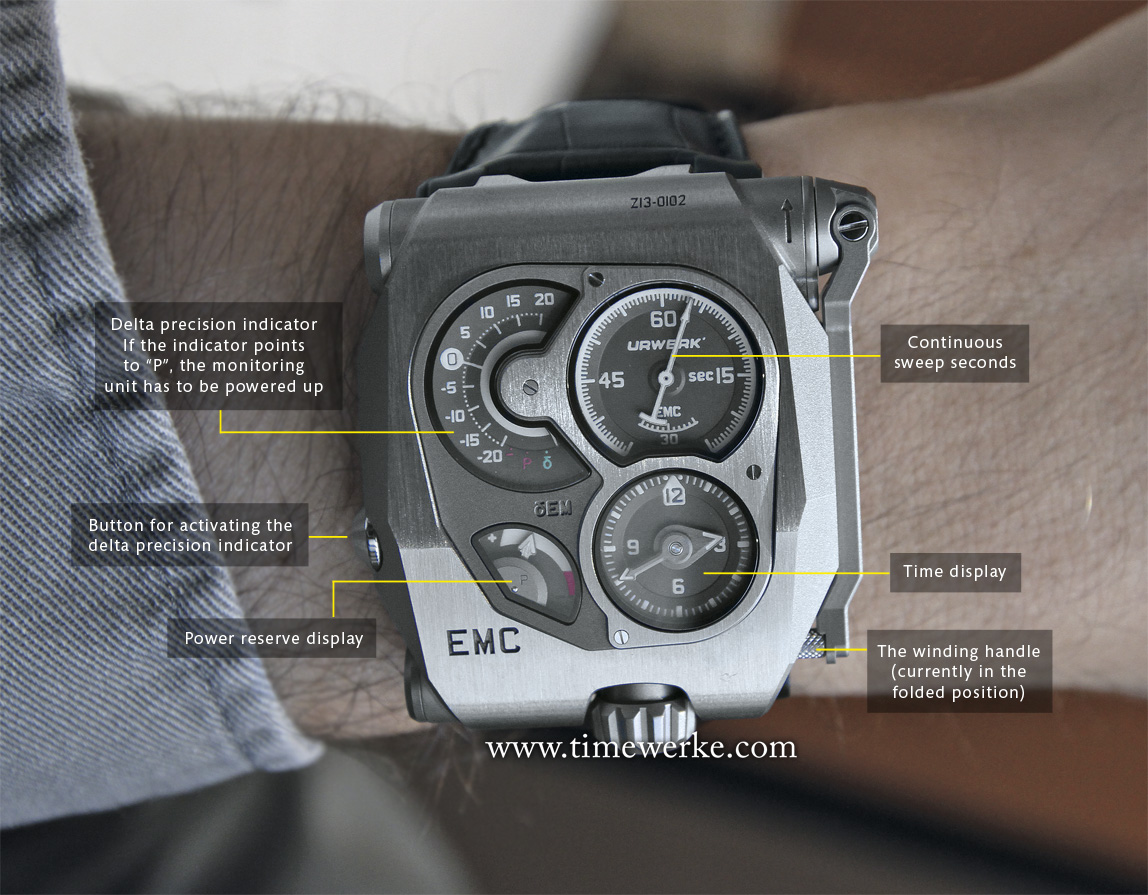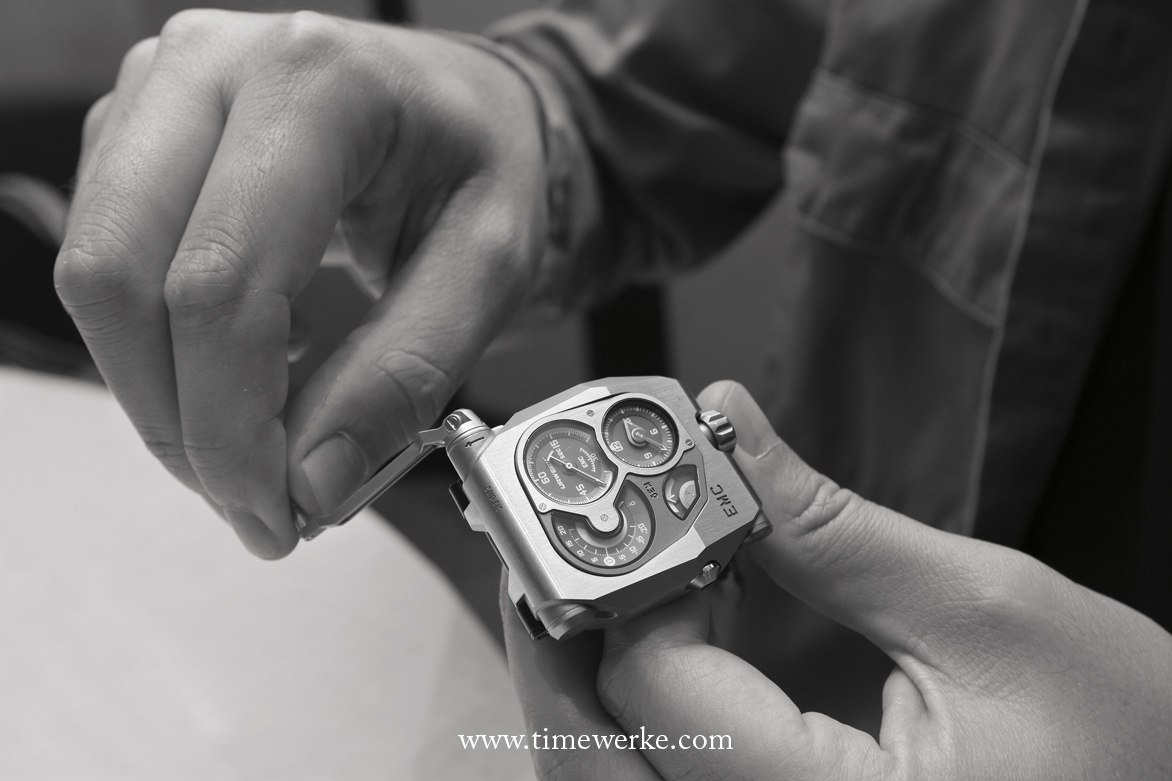
The Urwerk EMC as seen on the wrist of Felix Baumgartner. Note: This is a working piece. Click on the image and enlarge for a better view. Photo: © TANG Portfolio
Heard of Urwerk’s latest revolutionary timepiece known as the EMC, the abbreviation for Electro Mechanical Control? Well, now you have.
More importantly, why is the Urwerk EMC deemed disruptive to conventional wisdom in watchmaking?
According to the brand, the objective is to offer Urwerk’s owners (through the EMC) the tools that not only assesses but maintains the precision of their wristwatches.
How would this be achieved? Well, their idea was to integrate into a wristwatch a calculator, an optical sensor and a timing indicator, among other things, which are powered by a generator. These components make up an electronic monitoring mechanism.
How would such components fit into a wristwatch? Even more bizarre were Urwerk’s plans to specifically include a 16 million Hertz electronic oscillator and an integrated circuit board.
Was Urwerk either making a quartz watch or a hybrid somewhat like a “cyborg”? Has this independent brand finally succumbed to electronic timekeepers, leaving behind mechanical movements to move into quartz watches? Have the people behind the brand gone cranky?
Well, a better understanding of the Urwerk EMC will yield answers to these pressing questions.
What the good folks at Urwerk (founders Felix Baumgartner and Martin Frei) have attempted to do is to create a miniature timing machine that tests the precision of a movement. “We had the crazy idea,” concedes Felix Baumgartner, co-founder of Urwerk, “And that was to have an individual ‘Witschi’ machine miniaturized into your own wristwatch.”
This led the Urwerk team to create not just a miniature timing machine but their first in-house movement as well. Their in-house Calibre is the manual-winding UR-EMC with a flat balance spring and the Swiss lever escapement oscillating at the frequency of 28,800 vibrations per hour or 4 Hertz.
The development of the Urwerk EMC spanned almost six years. Though there are electronics onboard the wristwatch, it is highly important to remember that the Urwerk EMC is still a 100% mechanical timepiece.
Take a look at the EMC watch (in the image above, case made of titanium and steel) which has four displays; the hours and minutes are read off the sub-dial at the bottom right-hand corner while the continuous sweep seconds is at the top right-hand corner. The power reserve display is at the bottom left-hand corner. The power reserve of the UR-EMC is 80 hours.
The remaining display at the top left-hand corner is the delta precision indicator. This is the display that indicates the precision of the EMC movement.
Before any attempt to measure the timing precision, the generator (from Maxon, the same company that produced motors for the Mars Rovers made by NASA) which is cleverly housed in a separate tubular chamber at the 12 o’clock position (which the winding handle is secured to at one end) that supplies electricity to the delta precision mechanism, must first be charged up manually.
This is done by unfolding the winding handle attached to the case and cranking it in a clockwise manner. There are therefore no batteries involved; power comes from the capacitor.

Cranking it up. Affixed to the watchcase is the crankshaft or handle that has to be unfolded and turned (as demonstrated by Felix Baumgartner) to charge the Maxon generator which supplies electricity to the monitoring unit. Photo: © TANG Portfolio
Having done so, the next step is to activate the button for the delta precision indicator found at the side of the case. Upon activation, the optical sensor will then time the vibrations of the balance for around three seconds and it will subsequently compute how fast or slow the movement is running.
The computer or integrated circuit board is what controls the optical sensor and it has the 16 million Hertz reference oscillator. The optical sensor is linked to the balance wheel which is made of ARCAP, an alloy that has non-magnetic and anti-corrosive properties.
With the information on precision provided, the owner can adjust the rate of the watch through the balance rate regulator via a timing adjustment screw located at the case back. The fine adjustments essentially lengthen or shorten the balance spring.
Following the adjustment, the watch is ready to be tested for its precision again and the delta precision indicator is called into action once more. The process is repeated till a comfortable test reading is achieved.
For us, Urwerk’s EMC is somewhat like the T-800 Series cyborg seen in the movie Terminator which can self-heal or “self-medicate”. With the EMC, the owner can monitor and adjust the precision on his own.
The EMC is therefore what Urwerk describes as “the first high-end mechanical watch with artificial intelligence”.
This is one timepiece with no benchmark – no reference standard simply because it is a mind-boggling revolutionary timepiece.
Indeed. So is it still fair to say that Urwerk is getting cranky? On the contrary, with the successful completion of the EMC, Urwerk is actually all cranked up for the next exciting phase of their horological adventure.
They’ll be back.


